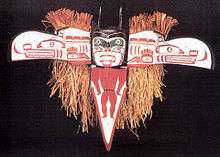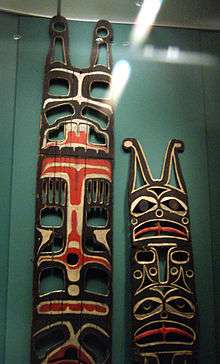Sisiutl
The sisiutl is a legendary creature found in many of the cultures of the Indigenous peoples of the Pacific Northwest Coast. It is typically depicted as a double-headed serpent with fish qualities, sometimes with an additional central face of a supernatural being. The sisuitl features prominently in Pacific Northwest art, dances and songs. The sisuitl is closely associated with shamans because both are seen as mediators between the natural and supernatural worlds.[1]

The word for "sisiutl" in Tsimshian is Laqaqua'sa, which literally means "both sides head".[2]
Form
The Sisiutl is typically depicted as a double-headed serpent, although it is sometimes shown with just one head. Kwakwaka'wakw depictions usually show a central, humanoid face between the double heads. All three heads are usually horned, and the serpent heads typically have protruding tongues and spiral or upturned noses, with crescents along the body.[1]
Other depictions, by the Kwakwaka'wakw or other Pacific Northwest peoples, omit or modify some of these features. The Tlingit "grubworm" or "woodworm" (caterpillar) is a "peculiarly northern" variation that lacks the central head, and has an insatiable appetite.[1]
Among Pacific Northwest cultures, horns or plumes indicate a supernatural being. The spiral nose (or "inflated nostrils") motif is used on Hamatsa masks depicting Baxbaxwalanuksiwe, where it indicates hunger (dilated nostrils to sniff out food). The protruding tongue is associated with lightning, supernatural power, and the transfer of power from an animal source to a novice. Crescents may represent stylised scales or the segments of a caterpillar.[1]
Where a central humanoid head is depicted, it most often is taken to represent Baxbaxwalanuksiwe, although it has also been associated with Qomoqua. In the northern grubworm variant, the central head is believed to be the princess who suckled the grubworm.[1]
The sisiutl also sometimes takes the form of a canoe, as in a myth where it returns a woman from Qomoqua's spiritual realm to her home village, or a squirrel.[1]
Powers
The sisiutl is attributed with bringing both death and property; Paterson speculates that this may be "the basis for its double-headedness".[1]
The Kwakwaka'wakw myth "Squirrel and Thunderbird" describes the mortal Yayagextsa taking a scale from the sisiutl. The sisiutl describes the scale's powers:[1]
put the scale at the end of the arrow and nothing will live that is shot by you, even if it were a whale or an animal. When you wish it to become a rock, that which is shot by you, say to this arrow that it shall become a rock, and say to the arrow that what is shot by you will burn ...
In the northern woodworm variation, a Tsimshian "princess" who lived in a village called Khrain breastfed a "grubworm" (caterpillar), which grew to a large size and had a head on its tail. After the villagers killed the grubworm, a strange "big man" (chief) called out to the villagers from his canoe. Upon looking at him, the villagers died: "They were killed by the great supernatural power of the chief, who was the spirit of the great Grubworm".[1]
As a transformative creature of vast shamanic power, the Sisiutl could travel in and across all boundaries (worlds): land, water, & air. There is a belief among the Coast Salish that Sisiutl employ orca for transportation.
So powerful are Sisiutl, that contact, stepping on one's slime trail, or even seeing one, was believed to cause sickness or death. According to legend, looking at the sisiutl can turn a person into stone. However, if one kills a Sisiutl, it has healing powers.
Usage
Artifacts commonly adorned with Sisiutl include masks, “flying" props, power boards (dance boards), totem poles, clubs, knives, whistles, house beams, button blankets, setee, drums, wooden belts, pectoral ornaments, headdresses, frontlets, feast bowls, and canoe decorations.
Images or sculptures of Sisiutl were employed to guard canoes and cedar plank longhouses (the Sisiutl sculpture guarding one such house was said to flick its tongues as people approached). Warriors traditionally wear the sisiutl's emblem for protection in battle.
Many soulcatchers depict sisuitl, although other soulcatchers are undecorated or depict other animals.[1]
Enemies
Thunderbirds are one of the few predators of Sisiutl. Holly, and spat blood were some of the few implements able to harm a Sisiutl.
Associations
Sisiutl are associated with the salmon (one of Sisiutl's forms), Winalagilis (warrior spirit), the Sun (“Counselor of the World” steals the Sun's Sisiutl mask, releasing daylight to the world in one Kwakwaka'wakw myth), the moon, Land-Otter Canoe, woodworm, house of the sky people (Sisiutl guards it). A Sisiutl also guards the house of the Dzunukwa.
Ceremony
Dancers donning the mask of Sisiutl adorn themselves with western hemlock boughs, signifying wildness. Sisiutl masks were often hinged, allowing the serpent ends to simulate lifelike serpentine writhing movements. Sisiutl masks were decorated with flecks of mica, which were believed to be scales shed by Sisiutl (often found on beaches). These mica chips provided an enchanting glittery effect when danced in fire-light.
Tuxw'id (female warrior) dancers often incorporate Sisiutl in their performance, invoking Sisiutl to grant them the power of Winalagalis (warrior spirit): invincibility and immunity from pain. They may be seemingly pulled underground by a Sisiutl, or demonstrate their power by summoning dantsikw (sisiutl) power boards to rise from the earth commemorating the supernatural canoe of Winalagalis (a copper Sisiutl canoe that can travel underground). Supernatural powers bestowed by Sisiutl might be theatrically demonstrated by 'miraculously' surviving burning alive, or being decapitated.
In the Hawinalal, to demonstrate invincibility & immunity from pain, dancers don sisiutl girdles, and are suspended from the rafters of the plank house by skewers pierced through their backs and thighs. Hawinalal dancers also cut themselves with a sisiutl knife. (Boas, "Social Organization...", p. 485).
The Ha'mshamtses ("Eaters-of-the-Ground": secret cannibal society akin to Hamatsa) employs sisiutl transformation masks.
The ME'ila dancer (commemorates a boy who brought back magical treasures from the house of the moon, then remained to live there) carries a sisiutl club.
Gallery
 Raven/Sisutl transformation mask by Oscar Matilpi, Kwakwaka'wakw Nation, 1996. In the permanent collection of The Children's Museum of Indianapolis
Raven/Sisutl transformation mask by Oscar Matilpi, Kwakwaka'wakw Nation, 1996. In the permanent collection of The Children's Museum of Indianapolis The same Raven/Sisutl transformation mask, open, by Oscar Matilpi, Kwakwaka'wakw Nation, 1996. In the permanent collection of The Children's Museum of Indianapolis
The same Raven/Sisutl transformation mask, open, by Oscar Matilpi, Kwakwaka'wakw Nation, 1996. In the permanent collection of The Children's Museum of Indianapolis
In popular culture
The fantasy roleplaying game Dungeons & Dragons has a monster called the sisiutl in the book Stormwrack.[3]
Pseudo-scientific group the Society for Scientific Exploration theorised that the sisiutl, and other similar creatures in Pacific Northwest culture like the Sea-Wolf and the Haietlik, was based on real sightings of a cryptid, perhaps a Basilosaurus.[4]
See also
References
- Paterson, Roderick Paul (1975). The northwest coast sisiutl (Thesis). University of British Columbia.
- Boas, Franz (1891). "Vocabularies of the Tlingit, Haida and Tsimshian Languages". Proceedings of the American Philosophical Society. 29 No 136 (136): 173–208. JSTOR 982936.
- Baker, Richard; Carriker, Joseph D.; Wilkes, Jennifer Clarke (2005). Stormwrack: Mastering the Perils of Wind and Wave. Wizards of the Coast. ISBN 9780786936892.
- Swords, Michael D (1991). "The Wasgo or Sisiutl: A Cryptozoological Sea-Animal of the Pacific Northwest Coast of the Americas" (PDF). Journal of Scientific Exploration. 5 (1): 85–101.
- Boas, Franz. "Kwakiutl Ethnography." 1966. University of Chicago Press. London.
- Jonaitis, Aldona, ed. ."Chiefly Feasts: The Enduring Kwkaiutl Potltach." 1991. AMHH. Seattle.
External links
| Wikimedia Commons has media related to Sisiutl. |
- Mask Edward Curtis 1914
- Alert Bay grave totem pole
- Button blanket
- Headdress painting.
- Sisiutl board (pre 1900)
- Modern house beam
- Sisiutl as Archetypal Image
